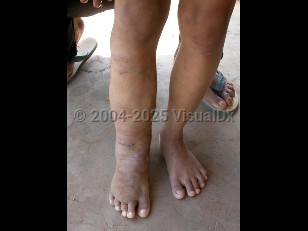Lymphatic filariasis
Alerts and Notices
Important News & Links
Synopsis

Lymphatic filariasis is an infection resulting from the transmission of the nematode species Wuchereria bancrofti, Brugia malayi, and Brugia timori to humans by mosquitoes. It is estimated that 120 million people worldwide have lymphatic filariasis or live with chronic lymphedema due to prior infection. The disease is endemic in many parts of Africa, Asia, South and Central America, and the Pacific Islands. More than two-thirds of infected people live in Asia, primarily in India. Risk factors include extended exposure to mosquitoes in endemic areas, especially near stagnant waters.
Approximately 50% of infections are asymptomatic. The remainder of infections represent either acute lymphatic inflammation or chronic lymphatic obstruction resulting in hydrocele or lymphedema of the limbs.
Acute filariasis is characterized by acute adenolymphangitis, lymphadenitis, and episodic fever ("filarial fever"). Due to chronic lymphatic vessel inflammation and scarring, chronic infection eventually results in primarily asymmetric swelling of the extremities, male genitalia (ie, hydrocele), and breasts in women. Chronic lymphatic disease is rare in children younger than 10 years, but risk increases with age.
Patients from endemic areas may occasionally experience chyluria (milky urine) as renal lymphatics are blocked. Additionally, acute and chronic infection may be associated with tropical pulmonary eosinophilia and peripheral eosinophilia.
The disease course can be prolonged over years to decades.
Approximately 50% of infections are asymptomatic. The remainder of infections represent either acute lymphatic inflammation or chronic lymphatic obstruction resulting in hydrocele or lymphedema of the limbs.
Acute filariasis is characterized by acute adenolymphangitis, lymphadenitis, and episodic fever ("filarial fever"). Due to chronic lymphatic vessel inflammation and scarring, chronic infection eventually results in primarily asymmetric swelling of the extremities, male genitalia (ie, hydrocele), and breasts in women. Chronic lymphatic disease is rare in children younger than 10 years, but risk increases with age.
Patients from endemic areas may occasionally experience chyluria (milky urine) as renal lymphatics are blocked. Additionally, acute and chronic infection may be associated with tropical pulmonary eosinophilia and peripheral eosinophilia.
The disease course can be prolonged over years to decades.
Codes
ICD10CM:
B74.9 – Filariasis, unspecified
SNOMEDCT:
240820001 – Lymphatic filariasis
B74.9 – Filariasis, unspecified
SNOMEDCT:
240820001 – Lymphatic filariasis
Look For
Subscription Required
Diagnostic Pearls
Subscription Required
Differential Diagnosis & Pitfalls

To perform a comparison, select diagnoses from the classic differential
Subscription Required
Best Tests
Subscription Required
Management Pearls
Subscription Required
Therapy
Subscription Required
References
Subscription Required
Last Reviewed:09/16/2020
Last Updated:09/22/2020
Last Updated:09/22/2020
Lymphatic filariasis

